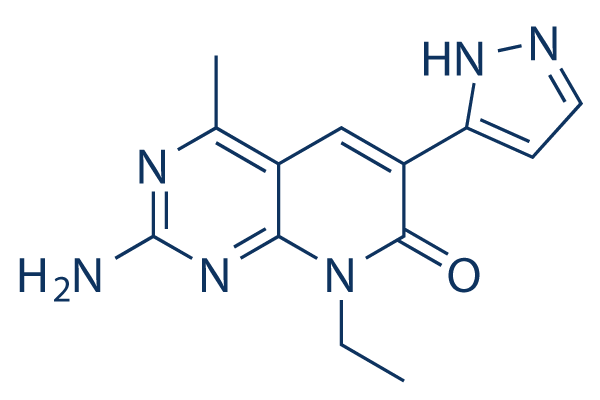
In vitro: Voxtalisib (XL765) is active against class I PI3K (IC50 = 39, 113, 9 and 43 nM for p110α, β, γ and δ, respectively). XL765 also inhibits DNA-PK (IC50 = 150 nM) and mTOR (IC50 = 157 nM) but not XL-147 which shows IC50 values of > 15 μM. XL765 treatment results in decreased cell viability in 13 PDA cell lines in a dose-dependent manner. XL765, a dual-target PI3K/mTOR inhibitor, inhibits cell growth and apoptosis in many more cell lines and at lower concentrations as compared to the PI3K-selective inhibitors XL147 and PIK90. The effect can be recapitulated by using combinations of single-targeted compounds. XL765 significantly reduces phosphorylation of the mTOR targets S6, S6K, and 4EBP1, which is associated with greater apoptosis induction rather than to PI3K inhibition alone. XL765 treatment causes accumulation of autophagosomes in MIAPaCa-2 cells, and results in significant dose-dependent AVO induction and LC3-II stimulation in MIAPaCa-2 cells stably expressing a LC3-GFP construct.
In vivo: The combination of XL765 (30 mg/kg) with chloroquine (50 mg/kg) results in significant inhibition of BxPC-3 xenograft growth in mice models, while XL765 alone at the same dose has no inhibitory effect. Oral administration of XL765 results in greater than 12-fold reduction in median tumor bioluminescence compared to control and improvement in median survival in nude mice implanted intracranially with GBM 39-luc cells. XL765 in combination with temozolomide (TMZ) yields a 140-fold reduction in median bioluminescence with a trend toward improvement in median survival compared with TMZ alone.
| Cell Experiment | |
|---|---|
| Cell lines | Pancreatic cancer cell lines |
| Preparation method | Cells are treated with XL765 24 hours after plating and harvested for apoptosis or autophagy assays at 24, 48, or 72 hours after XL765 treatment. Apoptosis is determined by total percentage of annexin V-positive cells by fluorescence-activated cell sorting (FACS). Acidic vesicular organelles (AVOs) are detected in XL765-treated cells by vital staining with acridine orange. The degree of AVO formation is expressed as fold increase of acridine orange fluorescence intensity (FL3) in XL765-treated cells versus control cells. |
| Concentrations | ~10 μM |
| Incubation time | 24, 48, 72 h |
| Animal Experiment | |
|---|---|
| Animal models | Female Nu/Nu mice inoculated s.c. with BxPC-3 cells |
| Formulation | Solubilized in water/10 mM HCl |
| Dosages | 30 mg/kg |
| Administration | oral |
| Molecular Weight | 270.29 |
| Formula | C13H14N6O |
| CAS Number | 934493-76-2 |
| Solubility (25°C) | DMSO 20 mg/mL |
| Storage |
Powder -20°C 3 years ; 4°C 2 years In solvent -80°C 6 months ; -20°C 1 month |
| Species | Mouse | Rat | Rabbit | Guinea pig | Hamster | Dog |
| Weight (kg) | 0.02 | 0.15 | 1.8 | 0.4 | 0.08 | 10 |
| Body Surface Area (m2) | 0.007 | 0.025 | 0.15 | 0.05 | 0.02 | 0.5 |
| Km factor | 3 | 6 | 12 | 8 | 5 | 20 |
| Animal A (mg/kg) = Animal B (mg/kg) multiplied by | Animal B Km |
| Animal A Km |
For example, to modify the dose of Compound A used for a mouse (20 mg/kg) to a dose based on the BSA for a rat, multiply 20 mg/kg by the Km factor for a mouse and then divide by the Km factor for a rat. This calculation results in a rat equivalent dose for Compound A of 10 mg/kg.
| Related PI3K Products |
|---|
| SNV4818
SNV4818 is a potential best-in-class (best-in-class) mutation-selective PI3K-α inhibitor with excellent selectivity for the H1047X mutant and moderate selectivity for the related E545/542X mutant. |
| hSMG-1 inhibitor 11j
hSMG-1 inhibitor 11j, a pyrimidine derivative, is a potent and selective inhibitor of hSMG-1, with an IC50 of 0.11 nM. |
| RLY-2608
RLY-2608 is a first-in-class, orally active, selective inhibitor of PI3Ka metabolism. |
| EDI048
EDI048 is an orally active Cryptosporidium PI4K inhibitor for the research of cryptosporidiosis. |
| PI3Kδ-IN-13
PI3Kδ-IN-13 is a PI3Kδ inhibitor (IC50=2.6 nM). |


Products are for research use only. Not for human use. We do not sell to patients.
© Copyright 2010-2023 AbMole BioScience. All Rights Reserved.
